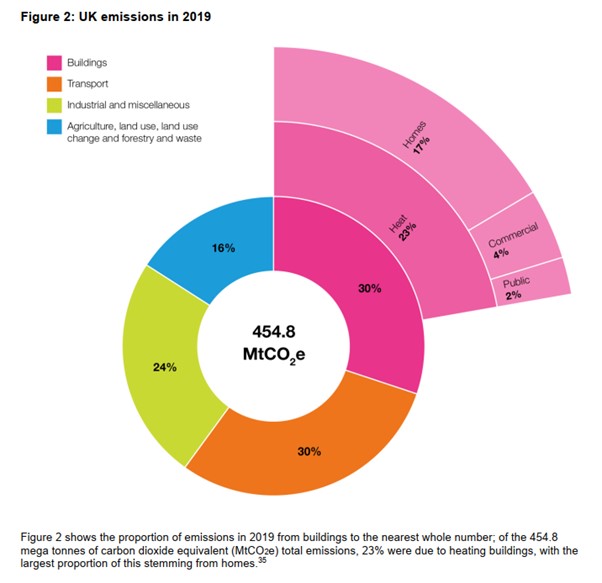January 2022 - Joel Gustafsson
Decarbonising heat – a simultaneously simple and complex energy transition
We spend most of our time in buildings. For those that work indoors, the ratio only goes up in the dark and cold winter months, sometimes amounting to spending almost all 24 hours of each day inside. When we consider that over the course of the 20th century, our expectations of comfort have increased considerably, it is easy to see why almost a quarter of the UK’s carbon emissions are directly attributed to heating buildings. By extension, any credible strategy to meaningfully reduce emissions, to Net Zero or otherwise, must address our reliance on natural gas as a source of heat.
There is an urgency to address this agenda – in July 2019, Cambridge set the UK temperature record of 38.7 degrees Celsius. But this is benign compared to the regions of the world experiencing forest fires and floods with increased frequency and severity. So what can we do? The answer is simple:
- Reduce heat demand – insulate buildings, reduce draughts, and use efficient ventilation
- Use electricity instead of gas – the decarbonisation of electricity is an established trend that is set to continue though the deployment of renewables, nuclear power and interconnectors to balance supply and demand
- Use electricity more efficiently– rather than a heater, use a heat pump (air, ground, water)
Pembroke’s decision to pursue an 100% heat pump (no gas backup) scheme for the Mill Lane site is an excellent example of this, with an impact that will extend far beyond the college walls. A site such as this (with multiple buildings of different ages, including some with high heat demand and a variety of uses) tends to be viewed as too risky to pursue any strategy without the insurance of fossil fuels, which makes the decision to do so more worthwhile.
There are various barriers which more generally prevent this approach from being widely adopted. I have identified these through my time discussing this topic from many angles – including setting the definition of Net Zero for buildings with the UK GBC, addressing technical issues in intelligent project delivery teams, and explaining what a heat pump is to family, friends, and neighbours. These barriers are:
- Motivation: why bother? – Natural gas (or methane) is a fantastic fuel – it can give high power output from small boilers, burning it is noise efficient, the equipment is reasonably cheap, the heat is instant and the fuel is abundant easy to store.
- Fear – Change brings uncertainty, and uncertainty is unsettling. There is an activation energy needed to drive change in any aspect of life – jobs, relationships, wallpaper. When it comes to heating systems, this activation energy appears to be quite high.
- Disruption – Reducing heat demand and moving away from gas impart some disruption, whether to do with cost, implementation, or impact on quality of life. Mitigating and managing these can be difficult and off-putting.
- Money – The point at which capital expenditure is justified by operational energy savings is highly variable. For some decarbonisation measures it can take decades, or not occur at all. The UK has the highest ratio of retail gas to electricity price in Europe, largely a political choice driven by taxes imposed on electricity. This harms the financial case to electrify heat.
- Trust – Will it work? Heat pumps suffer from trust issues, fuelled by the amount of mis-information available in the popular press and online.
- Inertia: the waiting game – Precedent is arguably the most influential factor in our decision making. It is time-consuming and draining to digest information, separate the wheat from the chaff and come to a decision led by objectivity, and far easier to wait and see what others do.
What now?
The barriers and hurdles I have witnessed and experienced are real, although in most cases perhaps the height of the hurdle is perceived to be higher than it is in practice.
But the technical solutions to deliver both demand reduction and a transition from gas are well-established and low risk when well-deployed. You can insulate historic buildings, you don’t always need to replace your heating system to use a heat pump, and there are capital grant schemes to assist with the costs. Whether delivered by gas, electric heaters or heat pumps, a well-designed and deployed heating system will work reliably and well, and as an industry we can deliver the energy transition successfully and reliably.
Nevertheless, it stands to reason that the motivation to consider alternatives must come from placing an intrinsic value on environmental impact, which is a luxury not afforded to the majority. The burden of assessing the technical considerations, accepting the risks, and then gritting your teeth and delivering the precedents falls to those brave enough to do so – which is why it is so good to see Pembroke leading by example.
Joel is the founder and director of JG Consulting. He established the business after 14 years in the industry to help clients understand the environmental impact of their projects and is driven by a desire to improve the performance of the built environment. Having completed a PhD in atmospheric chemistry, he entered the environmental design and engineering industry to maximize the positive impact of his work. He is motivated by real world outcomes. He is based in Cambridge and has worked across a range of sectors within the local area and beyond. Many of his projects have set important precedents that support reducing the environmental impact of the built environment.


